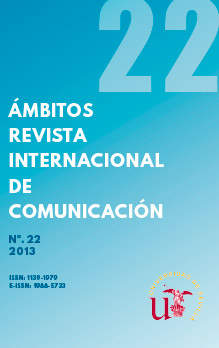Televisión y Redes Sociales: nuevo paradigma en la promoción de contenidos televisivos
Palabras clave:
Redes sociales, promoción televisiva, interactividad, twittersodios.Resumen
Una de las aplicaciones donde la industria televisiva encuentra un fructífero e inesperado punto de confluencia con Internet es en las redes sociales. Posibilitan la promoción de cualquier contenido, generando una vía de comunicación con gran capacidad de retroalimentación. Además se constituye como una herramienta de gran eficacia para establecer audiencias dinámicas interesadas en participar en sus contenidos televisivos. A través de las redes sociales, las cadenas pueden acceder a sus audiencias fuera del medio televisivo y, por tanto, permite superar gran parte de sus debilidades, como la fugacidad de sus mensajes o la imposibilidad de interactuación.Descargas
Citas
CARDOSO, G. (2008): Los medios de comunicación en la Sociedad en Red . Barcelona: Editorial UOC.
CHAN-OLMSTED, S. (2006): Competitive strategy for media firms: strategic and brand management in
changing media markets. New Jersey: Lawrence Erlbaum Associates, Inc., Publishers.
EASTMAN, S.T. (ed.) (2000): Research in media promotion. New Jersey: Lawrence Erlbaum Associates.
EASTMAN, S.T., FERGUSON, D.A. Y KLEIN, R.A. (eds.) (2006): Media Promotion and Marketing for
Broadcasting, Cable, and the Internet. Oxford: Elsevier.
JENKINS, H. (2009): Confronting the challenges of participatory culture. Chicago: MacArthur.
LÓPEZ GARCÍA, X. (2010): La metamorfosis del periodismo. Zamora: Comunicación Social ediciones.
MERRIT, D. (1988): Grafismo electrónico en televisión: del lápiz al píxel . Barcelona: Editorial Gustavo Gili.
SABORIT, J. (1988): La imagen publicitaria en televisión. Cátedra: Madrid.
ADELANTADO, E. y MARTÍ, J.: “Contenidos audiovisuales y televisivos para dispositivos móviles: una
aproximación al mercado español”. adComunica: Revista científica de estrategias, tendencias e innovación en
comunicación, nº 1, 2011, pp. 99-113.
DOYLE, G.: “From Television to Multi-Platform. Less from More or More for Less?”. Convergence: The
International Journal of Research into New Media Technologies, vol. 16(4), pp. 1-19.
FREITAS, C. y CASTRO, C.: “Narrativas audiovisuales y tecnologías interactivas”. Revista Estudios Culturales,
nº 5, 2010 , pp. 19-42.
GARCÍA MIRÓN, S.: “La sinergia web-televisión. Una nueva estrategia de fidelización de las cadenas
televisivas”. Hologramática, nº 9 (Octubre 2008), Vol.2, pp. 2-23.
ISLAS, O.: “El prosumidor. El actor comunicativo de la sociedad de la ubicuidad”. Palabra Clave, vol. 11 (Junio
, nº1, pp. 29-41.
MORALES, L.F. y HERNÁNDEZ, P.: “La webserie: convergencias y divergencias de un formato emergente de la
narrativa en red”. Comunicación: revista Internacional de Comunicación Audiovisual, Publicidad y Estudios
Culturales, nº 10, 2012 , pp. 140-149.
ROSIQUE, G.: “El papel del telespectador en los medios audiovisuales: de homo-spectador a homo-civis”.
Icono14, Vol. 8, nº 1, 2010, pp. 147-163.
VICTORIA, J.S. y ARJONA, J.B.: “La comunicación social de los nuevos canales audiovisuales en Internet:
WebTv”. Icono14, Vol. 7, nº 2, 2009, pp. 56-74.
FERRERAS, E. M. (2011): La estrategia de la corporación EITB (Euskal Irratia Telebista) en Facebook y Twitter.
Razón y palabra [en línea], nº 76, [Consulta: 27 septiembre 2011].
<http://www.razonypalabra.org.mx/N/N76/varia/4a%20entrega/36_Ferreras_V76.pdf>
PÉREZ CRESPO, S. (2007): IPTV internet: la perspectiva del futuro. Telefónica. Debate y conocimiento [en
línea] 24 noviembre 2007 [Consulta: 25 septiembre 2011].
Publicado
Cómo citar
Número
Sección
Licencia
Ámbitos. Revista Internacional de Comunicación es una revista de acceso abierto, lo que significa que todo su contenido está disponible gratuitamente para el usuario o su institución. Los usuarios pueden leer, descargar, copiar, distribuir, imprimir, buscar o enlazar con el texto completo de los artículos, o utilizarlos para cualquier otro fin lícito, sin solicitar permiso previo al editor o al autor. Esta definición de acceso abierto se ajusta a la Iniciativa de Acceso Abierto de Budapest (BOAI).

A menos que se indique lo contrario, todo el contenido de la edición electrónica se distribuye bajo una " licencia internacional Creative Commons Attribution-NonCommercial-ShareAlike 4.0 ". Puede consultar la versión informativa y el texto legal de la licencia aquí. Esto debe indicarse expresamente de esta manera cuando sea necesario.
En caso de aceptación del manuscrito, los autores ceden los derechos de la obra para su publicación a Ámbitos. Revista Internacional de Comunicación bajo el contrato de licencia Reconocimiento-NoComercial-CompartirIgual 4.0 Internacional (CC BY-NC-SA 4.0). Los autores conservan los derechos de autor y terceros están autorizados a copiar, distribuir y hacer uso de la obra, siempre que cumplan con los términos y condiciones establecidos en la licencia.
- Citar la autoría y la fuente original de publicación (revista, editorial y URL de la obra).
- No los utilice con fines comerciales.
- Si remezcla, transforma o crea a partir del material, debe publicar sus contribuciones bajo la misma licencia que el original.
Se puede encontrar más información en https://creativecommons.org/licenses/by-nc-sa/4.0/deed.es



















